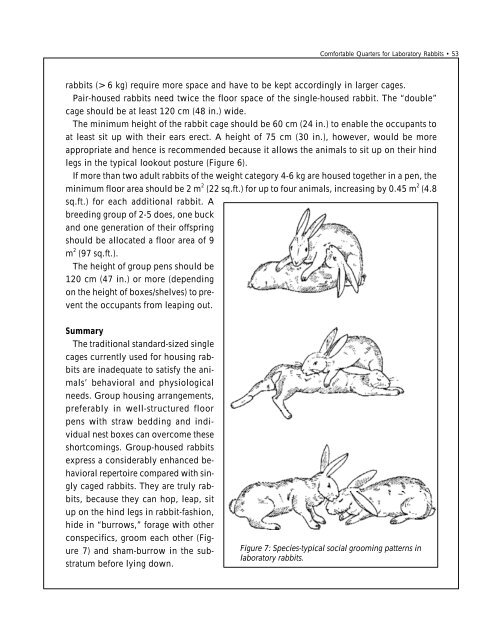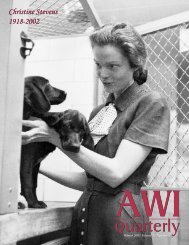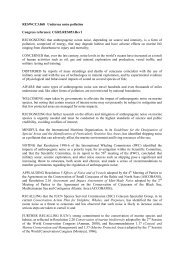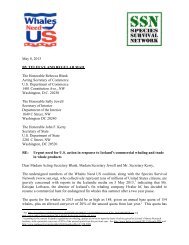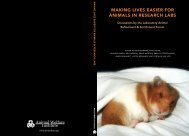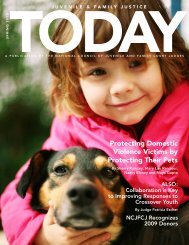Com<strong>for</strong>table Quarters <strong>for</strong> Laboratory Rabbits • 53<strong>rabbits</strong> (>6 kg) require more space and have to be kept accordingly in larger cages.Pair-housed <strong>rabbits</strong> need twice the floor space of the single-housed rabbit. The “double”cage should be at least 120 cm (48 in.) wide.The minimum height of the rabbit cage should be 60 cm (24 in.) to enable the occupants toat least sit up with their ears erect. A height of 75 cm (30 in.), however, would be moreappropriate and hence is recommended because it allows the animals to sit up on their hindlegs in the typical lookout posture (Figure 6).If more than two adult <strong>rabbits</strong> of the weight category 4-6 kg are housed together in a pen, theminimum floor area should be 2 m 2 (22 sq.ft.) <strong>for</strong> up to four animals, increasing by 0.45 m 2 (4.8sq.ft.) <strong>for</strong> each additional rabbit. Abreeding group of 2-5 does, one buckand one generation of their offspringshould be allocated a floor area of 9m 2 (97 sq.ft.).The height of group pens should be120 cm (47 in.) or more (dependingon the height of boxes/shelves) to preventthe occupants from leaping out.SummaryThe traditional standard-sized singlecages currently used <strong>for</strong> housing <strong>rabbits</strong>are inadequate to satisfy the animals’behavioral and physiologicalneeds. Group housing arrangements,preferably in well-structured floorpens with straw bedding and individualnest boxes can overcome theseshortcomings. Group-housed <strong>rabbits</strong>express a considerably enhanced behavioralrepertoire compared with singlycaged <strong>rabbits</strong>. They are truly <strong>rabbits</strong>,because they can hop, leap, situp on the hind legs in rabbit-fashion,hide in “burrows,” <strong>for</strong>age with otherconspecifics, groom each other (Figure7) and sham-burrow in the substratumbe<strong>for</strong>e lying down.Figure 7: Species-typical social grooming patterns in<strong>laboratory</strong> <strong>rabbits</strong>.
54 • Com<strong>for</strong>table Quarters <strong>for</strong> Laboratory <strong>Animal</strong>sIn situations where a rabbit has to be caged alone, access to a refuge area and objects <strong>for</strong>gnawing and playing should be provided. A single caged rabbit must never be kept in socialisolation but should always be able to have visual and possibly also olfactory contact withother <strong>rabbits</strong>.AcknowledgementI wish to thank Prof. D.B. Morton <strong>for</strong> his comments and support, and the Department ofBiomedical Science and Ethics, The Medical School, The University of Birmingham <strong>for</strong> theirhelp and funding of this work.Suggested further readingBatchelor GR 1991. Group housing on floor pens and environmental enrichment in SandyLop <strong>rabbits</strong>. <strong>Animal</strong> Technology 42, 109-120.Brooks DL, Huls W, Leamon C, Thomson J, Parker J, Twomey S 1993. Cage enrichment <strong>for</strong>female New Zealand White <strong>rabbits</strong>. Laboratory <strong>Animal</strong>s 22, 30-35.Gunn D 1994. Evaluation on <strong>Welfare</strong> in the Husbandry of Laboratory <strong>rabbits</strong>. DoctoralDissertation: University of Birmingham.Gunn D, Morton DB 1993. The behaviour of single-caged and group-housed <strong>laboratory</strong><strong>rabbits</strong>. Proceedings of the 5th Federation of European Laboratory <strong>Animal</strong> Science AssociationsSymposium, pp 80-84.Gunn D, Morton DB 1995. Inventory of the behaviour of New Zealand White <strong>rabbits</strong> incages. Applied <strong>Animal</strong> Behaviour Science 45, 277-292.Huls WL, Brooks DL, Bean-Knudsen D 1991. Response of adult New Zealand White <strong>rabbits</strong>to enrichment objects and paired housing. Laboratory <strong>Animal</strong> Science 41, 609-612.Love JA, Hammond K 1991. Group housing <strong>rabbits</strong>. Laboratory <strong>Animal</strong>s 20, 37-43.Morton DB, Jennings M, Batchelor GR, Bell D, Birke L, Davies K, Eveleigh JR, Gunn D,Heath M, Howard B, Koder P, Phillips J, Poole T, Sainsbury AW, Sales GD, Smith DJA,Stauffacher M, Turner RJ 1993 Refinements in rabbit husbandry. Second report of the BVAAWF/FRAME/RSPCA/UFAW joint working group on refinement. Laboratory <strong>Animal</strong>s 27, 301-329.Podberscek AL, Blackshaw JK, Beattie AW 1991a The behaviour of group penned and individualcaged <strong>laboratory</strong> <strong>rabbits</strong>. Applied <strong>Animal</strong> Behaviour Science 28, 353-356.Podberscek Al, Blackshaw JK, Beattie AW 1991b. The effects of repeated handling by familiarand unfamiliar people on <strong>rabbits</strong> in individual cages and group pens. Applied <strong>Animal</strong>Behaviour Science 28, 365-373.Stauffacher M 1992. Group housing and enrichment cages <strong>for</strong> breeding, fattening and <strong>laboratory</strong><strong>rabbits</strong>. <strong>Animal</strong> <strong>Welfare</strong> 1, 105-125.Whary M, Peper R, Borkowski GF et al. 1993. The effects of group housing on the researchuse of the <strong>laboratory</strong> rabbit. Laboratory <strong>Animal</strong>s 27, 330-341.


